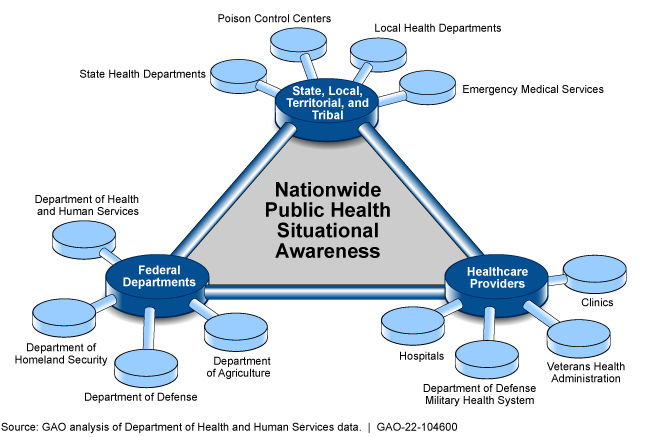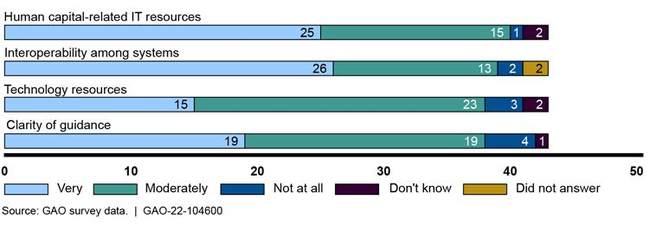GAO-22-104600 Published: Jun 23, 2022. Publicly Released: Jun 23, 2022.
Since 2006, federal laws have required the Department of Health and Human Services to develop a real-time electronic network that would improve the nation's situational awareness during a public health emergency. This network was meant to be used to facilitate early detection of and rapid response to potentially catastrophic infectious disease outbreaks—such as COVID-19.
However, this network is still not operational 15 years later.
We recommended that HHS prioritize the development of this network—to include designating a lead office for implementing it and clearly defining roles and responsibilities.
Types of Entities That Are to Share Information to Support Nationwide Public Health Situational Awareness

What GAO Found
Since 2006, multiple federal laws have mandated that the Department of Health and Human Services (HHS) take steps to improve the nation's situational awareness of threats related to public health emergencies, such as the COVID-19 pandemic. Specifically, HHS was required to establish a near real-time electronic nationwide public health situational awareness capability through an interoperable network of systems. This network was to be used to facilitate early detection of and rapid response to potentially catastrophic infectious disease outbreaks.
More than 15 years after the law initially mandated it, the federal government does not yet have this needed situational awareness network capability. If this network had been available, it could have been used to provide vital information to better manage a timely COVID-19 response.
The Pandemic and All-Hazards Preparedness and Advancing Innovation Act of 2019 reiterated the need for HHS to improve situational awareness capabilities. The following summarizes key requirements in the act and the extent to which HHS has implemented them as of March 2022.
Summary of statutory requirements related to the improvement of situational awareness for public health emergencies and the extent to which HHS has implemented them as of March 2022
|
Summary of requirements |
Implementation status |
|
Adopt technical and reporting standards. |
● |
|
Provide grants to establish integrated systems. |
◑ |
|
Develop a plan for sharing and securing information. |
○ |
|
Establish a near real-time electronic nationwide public health situational awareness and biosurveillance capability. |
○ |
|
Facilitate coordination among relevant agencies. |
○ |
|
Conduct a public meeting with experts in public health by December 21, 2019. |
○ |
|
Utilize applicable interoperability standards and define minimal data elements. |
○ |
|
Develop a strategy and implementation plan by December 24, 2020. |
○ |
|
Conduct a review of the data and information transmitted by the network by June 24, 2021 and every 6 years thereafter. |
○ |
|
Develop a budget plan by June 24, 2021, and on an annual basis thereafter. |
○ |
Legend: ● Requirement is fully implemented; ◑ Requirement is partially implemented; ○ Requirement is not implemented Source: GAO analysis of The Pandemic and All-Hazards Preparedness and Advancing Innovation Act of 2019 and other related laws, and Department of Health and Human Services (HHS) data. I GAO-22-104600
The lack of significant progress in implementing the requirements in the act is due, in part, to the department failing to prioritize the requirements of the act and not establishing an appropriate management and governance structure. Such a structure would include a lead operational division with defined roles and responsibilities for implementation of statutory requirements, and an organization to provide oversight of these efforts. During GAO's review, HHS began drafting a work plan intended to address the requirements of the 2019 act. However, HHS has not provided a time frame for completing the work plan.
In January 2022, GAO designated HHS leadership and coordination of a range of public health emergencies as high risk. For more than a decade, GAO has reported on HHS's execution of its lead role in preparing for, and responding to, public health emergencies and have found persistent deficiencies in its ability to perform this role. Similarly, HHS has not provided the leadership necessary to carry out its required responsibilities in the 2019 act.
Public health entities experienced a variety of challenges and identified lessons learned from the COVID-19 pandemic that could better inform HHS in developing and implementing the public health situational awareness and biosurveillance network. Specifically, state survey respondents identified a number of information-sharing challenges that they experienced in the management of public health information. The following summarizes the top four challenges state survey respondents most often rated as challenging.
State Reported Challenges in Managing Public Health Information during COVID-19

Additional challenges—limitations on data collected, increased reporting requirements, and impediments to health-related data sharing and collaboration—were identified by public health organizations at the national, state, and local levels. Thirty states identified lessons that HHS could use in planning for the network. The three lessons that states identified most often were
- improve public health reporting by, for example, standardizing and sharing data among federal entities and states to improve surveillance needs;
- collaborate early with stakeholders by, for example, involving state and local stakeholders throughout the entirety of emergency reponse activities; and
- establish a public health infrastructure to enable data sharing by, for example, implementing the network required by the 2019 act.
After having over two years of experience in responding to COVID-19, HHS had not taken steps, as of March 2022, to identify, document, and share all of the challenges and lessons learned from the pandemic. These challenges and lessons could be incorporated into the planning and implementation of the public health situational awareness and biosurveillance network. Until HHS takes steps to identify, document, share, and incorporate lessons learned from the COVID-19 pandemic, opportunities to improve the response to future and ongoing public health emergencies by learning from past challenges will likely be missed.
Why GAO Did This Study
The COVID-19 pandemic has drawn attention to the urgent need for public health officials to access real-time information about emerging threats to enable them to make timely, responsive decisions. For over a decade, federal law has mandated that HHS improve the nation's situational awareness of these threats.
The most recent mandate, enacted in 2019, included a provision for GAO to report on HHS's efforts to implement these improvements. The CARES Act also included a provision for GAO to conduct monitoring and oversight of the federal response to the pandemic.
This report examines (1) the extent to which HHS has made progress toward implementing the requirements in the 2019 act; and (2) the challenges and lessons learned from COVID-19 that HHS could incorporate in planning for a situational awareness and biosurveillance network.
GAO reviewed HHS documentation, such as grants provided to states, technical and reporting standards, and adoption plans. It also analyzed documentation and compared it to requirements in the act.
In addition, GAO surveyed public health officials from 50 U.S. states, the District of Columbia, and five U.S. territories. Thirty-nine states, the District of Columbia and three U.S. territories (hereinafter collectively referred to as states) responded to the survey, for a response rate of 77 percent. GAO assessed these responses to identify COVID-19 challenges and lessons learned. Further, GAO interviewed representatives from eight public health organizations representing state and local levels, such as the National Governors Association and National Association of County and City Health Officials, as well as HHS officials.
Recommendations
GAO is making 12 recommendations to HHS to prioritize the development of the public health situational awareness and biosurveillance network. Among these recommendations are that HHS should:
- designate a lead operational division for implementation of statutory requirements and clearly define its roles and responsibilities;
- identify the office responsible for overseeing the completion of the activities performed by the lead operational division and clearly define its roles and responsibilities;
- commit to a deadline for finalizing the work plan to implement the 2019 act requirements and ensure that the work plan is fully implemented;
- identify and document information-sharing challenges and lessons learned from the COVID-19 pandemic;
- share the lessons learned from the COVID-19 pandemic with relevant stakeholders, such as state, territorial, and local public health officials; and
- incorporate lessons learned from the COVID-19 pandemic into plans for implementing the situational awareness and biosurveillance network.
HHS concurred with 10 of the 12 recommendations. The department stated that the remaining two were under review. The two under review related to identifying the office responsible for overseeing the completion of the activities performed by the lead operational division and identifying and documenting information-sharing challenges and lessons learned from COVID-19.
Recommendations for Executive Action
| Agency Affected | Recommendation | Status |
|---|---|---|
| Department of Health and Human Services | The Secretary of HHS should prioritize the development of the public health situational awareness and biosurveillance network by designating a lead operational division for PAHPAIA implementation. (Recommendation 1) |
Open <label class="status-code-label">Open</label><p class="status-code-description"><p>Actions to satisfy the intent of the recommendation have not been taken or are being planned, or actions that partially satisfy the intent of the recommendation have been taken.</p></p> When we confirm what actions the agency has taken in response to this recommendation, we will provide updated information. |
| Department of Health and Human Services | The Secretary of HHS should clearly define the roles and responsibilities for the lead operational division responsible for PAHPAIA implementation. The roles and responsibilities should include the specific activities required in PAHPAIA. (Recommendation 2) |
Open <label class="status-code-label">Open</label><p class="status-code-description"><p>Actions to satisfy the intent of the recommendation have not been taken or are being planned, or actions that partially satisfy the intent of the recommendation have been taken.</p></p> When we confirm what actions the agency has taken in response to this recommendation, we will provide updated information. |
| Department of Health and Human Services | The Secretary of HHS should identify the office responsible for overseeing the completion of the activities performed by the lead operational division and clearly define its roles and responsibilities. (Recommendation 3) |
Open <label class="status-code-label">Open</label><p class="status-code-description"><p>Actions to satisfy the intent of the recommendation have not been taken or are being planned, or actions that partially satisfy the intent of the recommendation have been taken.</p></p> When we confirm what actions the agency has taken in response to this recommendation, we will provide updated information. |
| Department of Health and Human Services | The Secretary of HHS should ensure that the lead operational division, in developing the PAHPAIA work plan, includes the steps to be taken to address all of the required actions in PAHPAIA. (Recommendation 4) |
Open <label class="status-code-label">Open</label><p class="status-code-description"><p>Actions to satisfy the intent of the recommendation have not been taken or are being planned, or actions that partially satisfy the intent of the recommendation have been taken.</p></p> When we confirm what actions the agency has taken in response to this recommendation, we will provide updated information. |
| Department of Health and Human Services | The Secretary of HHS should ensure that the lead operational division, in developing the PAHPAIA work plan, includes specific near-term and longterm actions that can be completed to show progress in developing the network. (Recommendation 5) |
Open <label class="status-code-label">Open</label><p class="status-code-description"><p>Actions to satisfy the intent of the recommendation have not been taken or are being planned, or actions that partially satisfy the intent of the recommendation have been taken.</p></p> When we confirm what actions the agency has taken in response to this recommendation, we will provide updated information. |
| Department of Health and Human Services | The Secretary of HHS should ensure that the lead operational division, in developing the PAHPAIA work plan, includes time frames for implementing the near-term and long-term actions. (Recommendation 6) |
Open <label class="status-code-label">Open</label><p class="status-code-description"><p>Actions to satisfy the intent of the recommendation have not been taken or are being planned, or actions that partially satisfy the intent of the recommendation have been taken.</p></p> When we confirm what actions the agency has taken in response to this recommendation, we will provide updated information. |
| Department of Health and Human Services | The Secretary of HHS should ensure that the PAHPAIA work plan includes specific steps the department will take to oversee the progress of the actions the lead operational division takes to implement PAHPAIA requirements. (Recommendation 7) |
Open <label class="status-code-label">Open</label><p class="status-code-description"><p>Actions to satisfy the intent of the recommendation have not been taken or are being planned, or actions that partially satisfy the intent of the recommendation have been taken.</p></p> When we confirm what actions the agency has taken in response to this recommendation, we will provide updated information. |
| Department of Health and Human Services | The Secretary of HHS should commit to a deadline for finalizing the work plan to implement PAHPAIA requirements and ensure that the work plan is fully implemented. (Recommendation 8) |
Open <label class="status-code-label">Open</label><p class="status-code-description"><p>Actions to satisfy the intent of the recommendation have not been taken or are being planned, or actions that partially satisfy the intent of the recommendation have been taken.</p></p> When we confirm what actions the agency has taken in response to this recommendation, we will provide updated information. |
| Department of Health and Human Services | The Secretary of HHS should ensure that the lead operational division for PAHPAIA implementation identifies and documents the IT- and information sharing-related challenges and lessons learned from the COVID-19 pandemic. (Recommendation 9) |
Open <label class="status-code-label">Open</label><p class="status-code-description"><p>Actions to satisfy the intent of the recommendation have not been taken or are being planned, or actions that partially satisfy the intent of the recommendation have been taken.</p></p> When we confirm what actions the agency has taken in response to this recommendation, we will provide updated information. |
| Department of Health and Human Services | The Secretary of HHS should ensure that the lead operational division for PAHPAIA implementation shares the lessons learned from the COVID-19 pandemic with relevant stakeholders, such as state, territorial, and local public health officials. (Recommendation 10) |
Open <label class="status-code-label">Open</label><p class="status-code-description"><p>Actions to satisfy the intent of the recommendation have not been taken or are being planned, or actions that partially satisfy the intent of the recommendation have been taken.</p></p> When we confirm what actions the agency has taken in response to this recommendation, we will provide updated information. |
| Department of Health and Human Services | The Secretary of HHS should ensure that the lead operational division for PAHPAIA implementation request that state, territory, and local public health officials share their lessons learned from the COVID-19 pandemic with HHS. (Recommendation 11) |
Open <label class="status-code-label">Open</label><p class="status-code-description"><p>Actions to satisfy the intent of the recommendation have not been taken or are being planned, or actions that partially satisfy the intent of the recommendation have been taken.</p></p> When we confirm what actions the agency has taken in response to this recommendation, we will provide updated information. |
| Department of Health and Human Services | The Secretary of HHS should ensure that the lead operational division for PAHPAIA implementation incorporates lessons learned from the COVID- 19 pandemic into its plans for implementing the situational awareness and biosurveillance network. (Recommendation 12) |
Open <label class="status-code-label">Open</label><p class="status-code-description"><p>Actions to satisfy the intent of the recommendation have not been taken or are being planned, or actions that partially satisfy the intent of the recommendation have been taken.</p></p> When we confirm what actions the agency has taken in response to this recommendation, we will provide updated information. |
Full Report
"network" - Google News
June 24, 2022 at 12:31AM
https://ift.tt/AnY1Qpv
COVID-19: Pandemic Lessons Highlight Need for Public Health Situational Awareness Network - Government Accountability Office
"network" - Google News
https://ift.tt/IUFYAtu
Shoes Man Tutorial
Pos News Update
Meme Update
Korean Entertainment News
Japan News Update

No comments:
Post a Comment